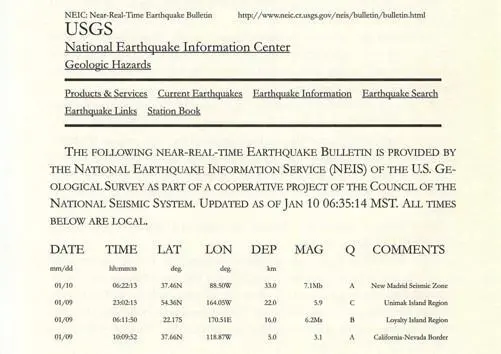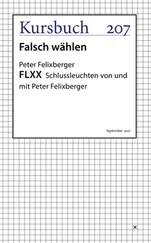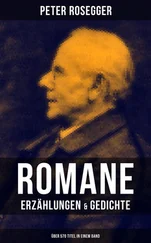The quake had occurred four hours earlier. It measured a magnitude 7.1 on the Richter scale.
Stunned, Holleran hurried to her bedroom where she kept her laptop. Within seconds she was hooked into the Internet site for the U.S. Geological Survey’s National Earthquake Information Center. Based in Boulder, the center continually updated seismic episodes around the world.
There were already several entries for the New Madrid quake. The epicenter was approximately 120 miles north of Memphis in extreme southwestern Kentucky. The earthquake had hit at 12:22 Universal Time. Some buildings in Memphis had collapsed, and there were early reports of loss of life.
Holleran nervously tapped in the homepage for the USGS Center for Earthquake Research at the University of Memphis. It was the main clearinghouse for the New Madrid Seismic Zone. She watched as a profile of the quake’s seismic pattern slowly scrolled down on the screen. It was striking.
The east-west ground motion was exceptionally violent. The P and S waves looked like saw-toothed mountain peaks interspersed with plunging valleys. P stood for the primary wave. It arrived first. The S, or secondary, wave was slower-moving but harder-hitting. Both were body waves, originating in the body of the rock. The amplitude—represented by the height of the wave—was pronounced. The shaking had lasted forty seconds. So the quake was of fairly long duration.
Holleran punched a couple of computer keys and got a model of the P and S waves.

The S waves had continued for nearly fifteen seconds. Their elastic vibrations sheared or twisted rock sideways and moved the earth with an up-and-down, side-to-side motion. The quake’s surface waves, the Love and Rayleigh waves, had also been of long duration.
The quake had been felt five hundred miles away in Chicago, where the skyscrapers along Michigan Avenue had swayed slightly. The buildings hadn’t suffered any damage, but the oscillations had continued for a full minute. Moderate damages—mainly collapsed chimneys and broken gas lines—were reported in St. Louis about 170 miles away. There were similar reports from Little Rock and Louisville. The quake had been felt in Pittsburgh and Charleston, South Carolina.
Those distances were a little short of incredible to a California-trained seismologist like Holleran.
The radio had an update about injuries in Memphis. Eleven people were dead, crushed in their cars when a section of a highway overpass had fallen. Hospital ERs were jammed and the death toll was expected to rise. An old, river city like Memphis had an abundance of unreinforced brick buildings. Holleran would bet some of them had crumbled like card castles when the first strong waves hit.
Her pulse racing, Holleran took some breaths to try to settle down. Her hands were trembling when she picked up the telephone to call Jim Dietz.
Holleran pressed the auto dialer for the dig site at Point Arguello. Dietz picked up the phone. He’d already been at work for an hour and had gone back to the trailer to fill his water jug.
“Did you hear about the quake in New Madrid?” she asked.
“I just checked out the Internet site at Boulder,” he said. “Pretty nice magnitude.”
“Jim, I’m not going to make it out there today.”
“You finally got that big date, right?” Dietz, as ever, his charming self.
“I’m going to Memphis.”
The line went quiet. She began to tell him about Otto Prable.
MEMPHIS
JANUARY 10
1:15 P.M.
PILLARS OF THICK BLACK SMOKE FRAMED THE TALL buildings downtown, the Midwest Bank and Raldo Towers, as well as the two bridges over the Mississippi. There was more smoke than Atkins had expected. More fires. He figured most of them had probably started after the earthquake shattered gas lines. Entering Memphis on Route 61, he’d just gotten his first good look at the city’s skyline.
He picked up Interstate 40 just after it crossed into the city from West Memphis, six lanes of stalled traffic going in either direction. The Pyramid, the city’s distinctive riverfront auditorium, was right behind him. A five-story brick warehouse was burning fiercely a couple blocks off the highway. The dancing flames were giving everyone a hell of a show.
Atkins had a perfect vantage point. He could look right down Thomas Street from the elevated highway. Fire trucks—pumpers, snorkels, and other pieces of heavy equipment—encircled the building. It looked solid, thick-walled, old. Watching from the driver’s seat. Atkins worried that the firefighters were much too close. There was no telling how much the walls had been weakened or what would happen in a good aftershock.
Atkins rolled down a window. The wail of sirens seemed to be coming from a dozen directions at once. The Memphis fire department was probably stretched pretty thin by now. Fire was often the big killer in an earthquake. A lot of people didn’t realize that. Even those who should have known better like building engineers who routinely forgot to turn off gas and electrical power after a quake.
Listening to the sirens—the sound seemed to wrap around the entire city—Atkins wondered how many people had been hit by falling masonry or glass. Rushing into the street during an earthquake was another common, often fatal mistake. A natural reaction, Atkins had done it himself. But it could be deadly around tall buildings.
None of the city’s new skyscrapers had collapsed, but the ground waves had made them sway like trees in a strong wind. Some of the windows had exploded, raining glass on the streets.
As he listened to the radio, Atkins knew that the worst damage was centered just south of Beale Street, the famous blues mecca, where many of the homes and low-rise buildings had shifted on their foundations. That’s where some of the biggest fires had broken out.
Damage in the city was spotty but widespread. Even Walter Jacobs’ office at the University of Memphis had taken a hit. The Center for Earthquake Studies was located in a converted two-story home on the edge of the campus. The chimney and part of the cornice had crashed through the roof into one of the bathrooms. A grad student who showed up early to crunch numbers on a computer in an adjoining room had a close call.
Atkins had gotten a rough description from Jacobs by cell phone. They decided to meet at the scene of a building collapse. Some bricklayers had been salvaging their work on the walls of a discount shopping center. Two twelve-foot-high sections of solid brick had fallen over in one of the aftershocks, crushing the men. Rescuers were frantically trying to dig out any survivors.
All told, a pretty bad quake, but nothing like a big one. You had to experience a magnitude 7.5 quake or greater to appreciate what could happen. Live through one; lose a good friend. Or maybe the woman you wanted to marry. That’s how Atkins tended to grade earthquakes. It was his own personal scale of magnitude. Memphis had been rocked, but its 7.1 hadn’t been a real killer. It wasn’t like Luzon in 1990, or Kobe, or Mexico City.
Still, this one had been something. The image of the ground rolling like an ocean wave stuck in his memory. He’d never seen anything like that firsthand.
It hadn’t happened for a while, but as Atkins made his way off the interstate and headed south on Martin Luther King Boulevard, the old memories came back. He remembered the evening before the quake had hit Mexico City. He was powerless to stop the images from coming, or even slow them down. How Sara and he had made love on the small bed in their hotel room.
Atkins had had the feeling then that Sara wanted all of him, and for the first time in his life, he was ready to give it, to surrender to someone entirely. That night he decided he would share his life with her. He would hold nothing back. She understood and responded with her body in a way she never had.
Читать дальше













